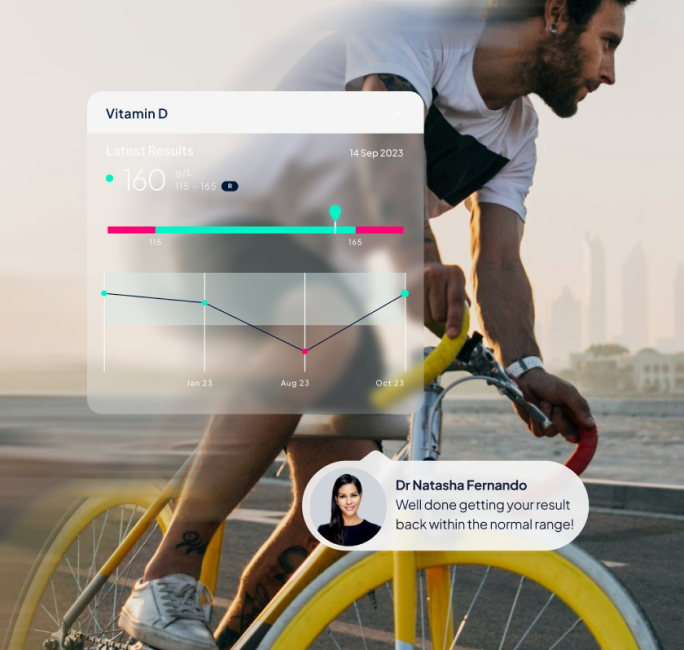Take control of your heart health with our at-home Cholesterol Blood Test. This quick finger-prick test provides a breakdown of your cholesterol levels, giving you insights to reduce your heart disease risk. Whether you're managing high cholesterol or proactively addressing lifestyle factors, this test helps you make informed changes.

Go beyond the numbers
Get ready to elevate your health understanding with a personalised doctor's report. Go beyond results and tap into expert insights tailored just for you.
- Actionable advice
- Expert support
- Tailored recommendations

How it works
You have the flexibility to choose what works best for you. Enjoy the comfort of having a friendly nurse visit your home for a quick blood draw, opt for a convenient visit to one of our nationwide partner clinics, or self-arrange a draw at a location that suits you.
Take control of your health with Medichecks – order your blood test today!

Track, improve, and monitor your health over time.
MyMedichecks is your personal online dashboard where you can view your results, access clear and simple explanations about individual health markers, monitor changes in your health, and securely store information about your medical history, lifestyle and vital statistics.
What's in the test?
Cholesterol status
Total cholesterol
Learn more
LDL cholesterol
Learn more
Non-HDL cholesterol
Learn more
HDL cholesterol
Learn more
Total cholesterol : HDL
Learn more
Triglycerides
Learn more
How to prepare for your test
Prepare for your Cholesterol Blood Test by following these instructions.
Fasting and hydration
- Avoid fatty foods for eight hours before your test, you do not need to fast.
Test limitations
Reviews
FAQs
What can I learn from this at-home cholesterol test?
What are the causes of high cholesterol?
High cholesterol is mainly caused by lifestyle factors like eating too many fatty foods and not getting enough exercise. However, there are other causes unrelated to lifestyle that can increase your risk. These include a family history of high cholesterol, a thyroid condition, and diabetes
What is cholesterol?
Cholesterol, known as a lipid, is a fatty substance in your blood. It plays an essential role in how your cells work, and in making vitamin D, bile acid, and vital hormones, such as testosterone and oestrogen.
But too much cholesterol in your blood (known as hypercholesterolaemia) can seriously affect your health, as it increases your risk of a heart attack or stroke.
What happens if my cholesterol is high?
Can I reduce high cholesterol?
For some people, diet and other lifestyle-related changes can help to reduce cholesterol levels. These include eating more fibre and foods rich in omega-3 fatty acids, following a Mediterranean diet, and eating less saturated fat. But others may struggle to reduce their cholesterol levels through lifestyle changes alone and may need cholesterol-lowering medications like statins.
What is a normal cholesterol level?
Your target cholesterol levels will depend on your cardiovascular risk and any underlying health conditions.
As a general guide, the NHS gives the following targets:
| Total cholesterol | ≤ 5 mmol/L |
| HDL | ≥ 1 mmol/L for men; ≥ 1.2 mmol/L for women |
| LDL | ≤ 3 mmol/L |
| Non-HDL | ≤ 4 mmol/L |
| Triglycerides | ≤ 2.3 mmol/L |
You can see if your cholesterol levels are within the normal range on your MyMedichecks dashboard. You’ll also get doctor’s comments and advice on any next steps. Our blog can also help you to make more sense of your numbers.
Where can I get a cholesterol blood test?
How can I check my cholesterol at home?
How does this test measure bad cholesterol?
Our Cholesterol Blood Test measures non-HDL cholesterol (bad cholesterol) by subtracting your HDL (good) cholesterol result from your total cholesterol.
This means our home cholesterol test includes all the non-protective and potentially harmful cholesterol in your blood and is an effective indicator of cardiovascular risk.
Do men have higher cholesterol levels than women?
Women naturally have higher HDL (good) cholesterol levels than men due to hormonal differences. However, there’s no difference in a man’s or woman’s genetic predisposition for high levels of a bad cholesterol known as low-density lipoprotein (LDL).
During pregnancy, cholesterol and triglyceride levels naturally increase. This ensures there’s greater availability of nutrients for the placenta and supports the growth and development of the baby as pregnancy progresses.
Women should aim for an HDL cholesterol level above 1.2 mmol/L, while men should aim for above 1 mmol/L.








